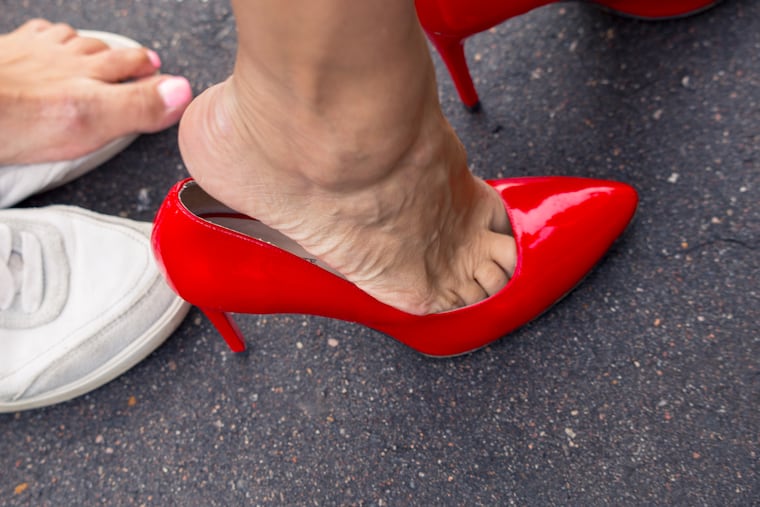How to choose shoes now to avoid foot pain and surgery later
Here are some tips for buying shoes that won't ruin your feet.

Kate O’Connor, an orthopedic surgeon who specializes in foot and ankle problems at Penn Medicine, is an expert on the damage that bad shoes can cause, especially to women who care more about fashion than their cramped, aching feet.
“If it’s really cute, it’s probably not comfortable,” she tells her patients. And, if it’s not comfortable, you’re increasing your odds of having to spend time in the future with a doctor such as O’Connor, who might have to fuse joints, cut bones, and move your tendons around.
Several doctors who routinely see damaged feet -- O’Connor; John Bruza, a Penn Medicine geriatrician; Casey Jo Humbyrd, chief of the foot and ankle division at Johns Hopkins department of orthopaedic surgery; Joshua Moore, a clinical associate professor of surgery at the Temple University School of Podiatric Medicine; and Steven Raikin, director of the foot and ankle service at Rothman Orthopaedic Institute -- shared shoe-buying suggestions.
Bruza, whose average patient is 84, said seeing the doctor can be a big event for people that age. It’s not unusual for a woman in her 90s to get her hair done, dress up, and put on high heels to visit him. “One of the first things I tell them is, ‘I don’t ever want to see you in those shoes,’” he said.
The shoes put elderly women at higher risk for falls, which can be catastrophic in late life. But they’re not good for young women, either. Raikin pointed out that they make your ankles wobble with every step, and that puts extra stress on tendons and joints you’ll wish you’d treated better when you get older. Every inch of heel increases stress on the ball of your foot by 25 percent. Hence, that part of the foot is supporting 75 percent more weight in a three-inch heel than it would in a flat shoe. Stress is also higher on the ligaments and tendons that support the bones of the foot. Plus, high-heeled shoes often lack arch support.
Unlike some animals' feet, humans' are meant to make full contact with the ground when we walk.
“We are not horses,” Humbyrd said. “When we wear high heels, we’re trying to walk like them.”
To make matters worse, spike-heeled shoes are often pointed in front -- unlike our feet. That’s another no-no. Even if they are flat, V-shaped shoes push your toes into unnatural positions. Although there is a genetic component to bunions, pointy shoes are also a culprit. The shoes force your big toe toward the little toe, where it doesn’t belong. That then crowds all the other toes, forcing some into contorted hammer toes.
The result can be painful, misshapen toes when you’re hitting your 50s and up. There’s a reason these problems are more common in women, but some trendy men’s shoes are shaped more like speed boats than toes in front. Be forewarned, gentlemen.
The doctors hate flip flops. “Flip flops are horrible,” said Moore, who generally doesn’t blame shoes for foot problems. Not only do these sandals lack arch support, they require wearers to curl their toes under to keep the shoes on when they walk. That can cause hammer toes, he said. Ballet flats are bad because most lack arch support.
If you’ve insisted on wearing the same size shoe long past your 20s, you’re probably wearing shoes that are too small. That also crowds toes. Our feet lengthen and widen with age, and especially with pregnancy and weight gain. It’s normal to need bigger shoes even if you can wear the same dress or pants size.
Buy a size and style that's comfortable in the store, doctors said. Don't ever assume it will feel better later. You should feel some arch support. There should be room on the sides and at the top for your toes. The heel should fit snugly. Doctors sympathize if you say the selection of comfortable, good-looking and affordable shoes is, to put it kindly, small. Shoe manufacturers won't get the message that we need more shoes that fit until we stop buying pretty torture devices.
O'Connor said that shoes with laces make it easier to adjust to the shape of your feet.
Keep in mind that, for many people, the second toe is longer than the big toe. If you buy a length that keeps the big toe happy, you may still push the second toe back. That's another way to end up with hammer toes.
Running shoes may need to be a half to full size larger than your work shoes, Humbyrd said. She buys hers in a store where she can try them out on a treadmill.
Bruza said there are some special considerations for the elderly. Family members tend to think that older people should wear highly cushioned running shoes. But their rubbery soles can catch on carpet and cause falls.
They can also exacerbate sensory and balance issues that become more common late in life. Some elders can feel disoriented in thick soles. “It’s like putting giant marshmallows on people’s feet and they can no longer feel where their feet are.”
Bruza said they’re better off with shoes that have thinner soles and some arch support. Socks are also important for preventing friction. Swelling is very common in old age and may respond to compression socks.
Even if you’ve had bad shoe habits for a lifetime, you can help your feet by changing now, the doctors said. It’s never too late, Humbyrd said, to start wearing good shoes.